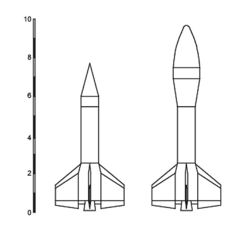Engineering:Falstaff (rocket)
Falstaff was a British sounding rocket used during the 1970s as part of the Chevaline programme to improve the penetrability of the Polaris nuclear missile. It was the largest UK rocket with a solid booster ever launched.
Polaris
The Falstaff was part of the Chevaline programme to improve the Polaris programme.[1][2] The Penetration Aids Carrier (PAC) was capable of maneuvering a Falstaff rocket and dispensing missiles.[2] According to John Pitfield, the PAC was launched in 1969, 1975, 1976 and 1978.[2]
Since the Australian government at the time was not in favour of nuclear weapons, the testing of the Falstaff vehicles on Australian soil had the potential to cause embarrassment. The details of over 4000 launches from the Woomera Range are still not fully released.[2]
Before the revelation that the Falstaff rockets were part of a nuclear program, anti-nuclear campaigners in Australia had believed that testing ended in 1963.[1][2]
Design
The Falstaff with the Stonechat Mk 2 booster was 5.3 m (17 ft) long and had a diameter of 92 cm (36 in). It weighed 5.09 tonnes (5.01 long tons; 5.61 short tons) of which 4.34 tonnes (4.27 long tons; 4.78 short tons) was solid propellant.[3] It delivered an average thrust of 240 kilonewtons (54,000 lbf) during 37 seconds.[3]
A launch on 1 October 1969 used the Stonechat Mk 1 booster.[3]
Launches
The Falstaff was launched eight times between 1969 and 1979 at Woomera, Australia, seven of which were the Mk 2 variant.[3] There was one failure, on 23 April 1978.[3][4] All the launches were from the Woomera Test Range in Australia,[3] 500 kilometres (310 mi) north-west of Adelaide.
| Date | Site | Vehicle | Result |
|---|---|---|---|
| 1 October 1969 | Woomera | Mk.I | Successful launch |
| 9 May 1975 | Woomera | Mk.II F0 | Successful launch |
| 19 February 1976 | Woomera | Mk.II F0 1 | Successful launch |
| 23 May 1978 | Woomera | Mk.II F1 | Vehicle failed |
| 15 September 1978 | Woomera | Mk.II F2 | Successful launch |
| 5 December 1978 | Woomera | Mk.II F3 | Successful launch |
| 14 February 1979 | Woomera | Mk.II F4 | Successful launch |
| 4 April 1979 | Woomera | Mk.II F5 | Successful launch |
Commemoration
The Falstaff rocket was commemorated in an event cover that depicted a rocket recognisable as a Falstaff. 5 December 1978 was commemorated in such a way.[5]
References
- ↑ 1.0 1.1 "Secret nuclear testing at Woomera". ABC. 2 April 2002. http://www.abc.net.au/am/stories/s518339.htm.
- ↑ 2.0 2.1 2.2 2.3 2.4 O'Connell, Sanjida; Patrick, Barkham (1 April 2002). "Australia used for secret tests of UK ballistic missile". https://www.theguardian.com/uk/2002/apr/01/physicalsciences.australia.
- ↑ 3.0 3.1 3.2 3.3 3.4 3.5 "Falstaff vehicles". sat-net.com. http://www.sat-net.com/serra/falsta_e.htm.
- ↑ "Falstaff". Encyclopedia Astronautica. http://www.astronautix.com/stages/faltaff1.htm#more.
- ↑ "F3 6 Dec 1978 Falstaff 3 launch from Woomera (ACFF/227)". Steve Irwin Stamps. http://www.steveirwinstamps.co.uk/f3-6-dec-1978-falstaff-3-launch-from-woomera-acff227-21813-p.asp.
 |

